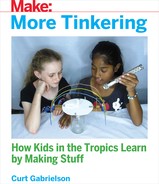Chapter 12
Finger Model and Bird Foot Dissection

Tinker the hand.
Have you ever really looked at your own hands? They are so elegantly complex that it blows the mind. Check out all the levers and cables under your skin and the fantastic number of different movements you can get out of that system. Here we’ll make a super-crude model of the system to enact just the simplest of motions.
Bird feet are similar in complexity, and we can take them apart, since someone else is going to eat the rest of the body. Over here, it’s not so common to eat the feet, but there are plenty of Chinese here, and they love chicken and duck feet, so it was not hard to find these at the store. You can do this tinkering with any bird feet that you find.
Gather stuff
- Bird feet
- Plates or cardboard to work on
Gather tools
- Razor blades and/or sharp knives
- Magnifying glass, if you have one
Tinker
Start by hacking away the skin up near the top of the leg stump. You’re looking for white tendons, a whole wad of them.
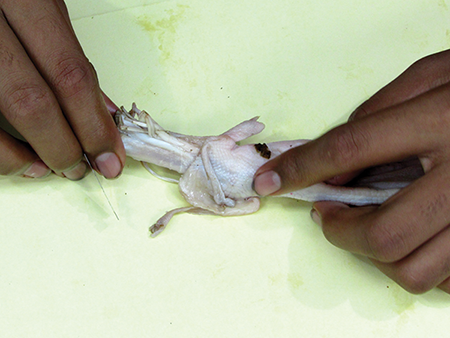
When you can isolate one, pull on it while holding the main part of the foot. See what moves.

Each one of those white tendons is connected to one of the tiny bones making up the toes of the foot. If you pull them all, the whole foot should curl up.
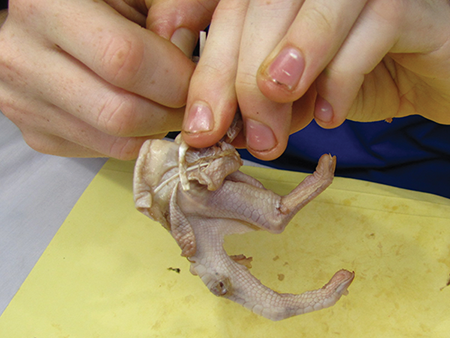
Sometimes they seem fused together, but try to get them apart for maximum movement. When you pull on one, you’ll see which toe comes up. Then you can start stripping around that toe to follow the tendon down. Get out your hand lens if you have one and inspect things close up.

You should be able to get all sorts of movement by pulling on different tendons.
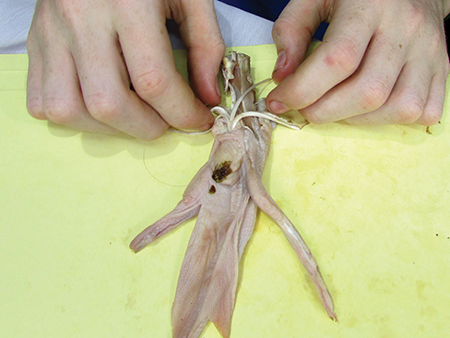
The ones on the top of the foot will make the foot lift up.

Keep on stripping off skin and separating tendons until you can get each part of each toe to move.
What’s Going On?
What you’re doing is just what the bird does when it walks, with your hand taking the place of the bird’s muscles. Bird feet are a lot like ours in that sense—not too many muscles down inside there. Muscles are up in our calf or the bird’s leg, and the force gets transferred to the bones by means of these tendons.
In biology, virtually every structure is a result of competition and adaptation, and ultimately evolution. The segmented structure of our hands and feet is similar to most other mammals as well as plenty of birds, reptiles, and amphibians. It’s clearly a structure that works in a diverse set of circumstances. From grasping branches to clawing through the duckweed to pulling tendons in a duck’s foot, segmented digits get the job done.
Marine mammals are an example of where it failed. Check out the arms and hands of a whale, dolphin, or seal, and you’ll see they’ve got most of the bones we have: single upper arm bone (humerus), double forearm bones (radius and ulna), and the three types of hand bone (carpals, metacarpals, and phalanges). But they barely use them! They’re all stuck together into a big fin that just flips back and forth in the water. That’s essentially why you’ve never seen a walrus playing piano—just wouldn’t work.
This was a case where the structure was not useful for these mammals that evolved back into the water, so it just sort of got put aside by evolution. Two little bone nubbins on each side halfway down are all that are left of the whale’s leg system; they’re called the vestigial pelvis.
But getting back to the tendons of hands and feet, robots arms can be made that use a similar system. Let’s make a crude model to see it in action.
Gather more stuff
- Straws, not too thin, no bendy part necessary
- Zip ties
- Small string like kite string or thin wire
- Narrow transparent cellophane tape
- Craft sticks or tongue depressors
Gather more tools
- Scissors
- Side cutters or hefty scissors to cut the sticks
Tinker
First we’ll make a super-simple version, which I got from my buddy Sam, on Instructables. He’s the mind behind The Oakland Toy Lab, with around 100 fine Instructables, but undoubtedly he nabbed this project from someone else, good tinkerer that he is. Bend the straw wherever you want a joint and cut out a little triangle.

Cut two or three of these along your straw, leaving one end without any cuts. You’re looking to cut about halfway through it so that when you open it up again, it looks like this.

Now slide a zip tie down through the straw so that the tip comes out the end with the holes. Bend the zip tie tip over the end of the straw and tape it on securely.

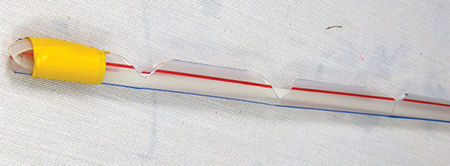
You’re done. Hold on to the non-taped end and yank on the zip tie. Way cool finger action.
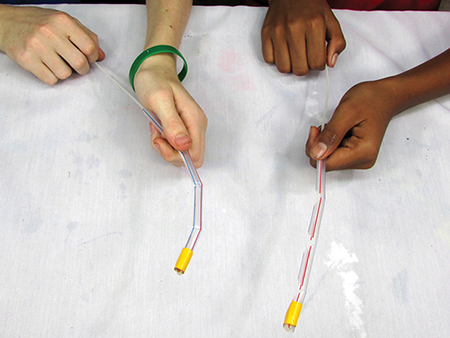
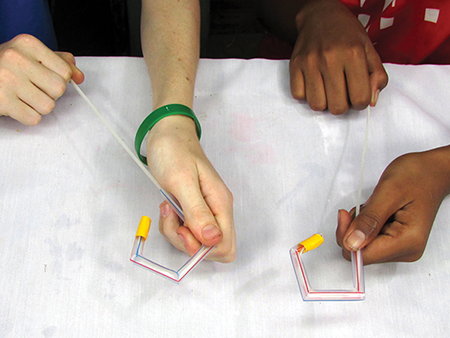
So that was pretty easy and fun, eh? It just happens to be anatomically incorrect. Sorry about that. Hey, I wanted you to have the fun before I broke it to you. Look: bend your fingers into a fist and then let your hand go limp. Do your fingers spring back up like that happy straw? Methinks not. If you want them to stretch out again you have to pull them back up. So let’s make another model that’s closer to reality.
Start with the bones: craft sticks. You can use larger craft sticks or tongue depressors if you want to. Cut them into pieces about 5 cm long. The point is to have some segments that are solid like bones. Leave one long to hold on to.

Now cut some straw segments. You’re going to put these segments on both sides of the sticks. The straw segments on one side have to be exactly the same length as the sticks, and the ones on the other side have to be slightly shorter.

Before you go any further, tape these segments together. Run a strip of cellophane tape right down from top to bottom, then turn it over and do it on the back too. Have the sticks touching, but just barely. When you’re done, the segments should be held pretty tightly but still be able to bend.
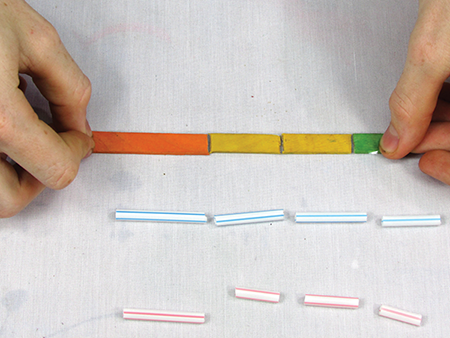
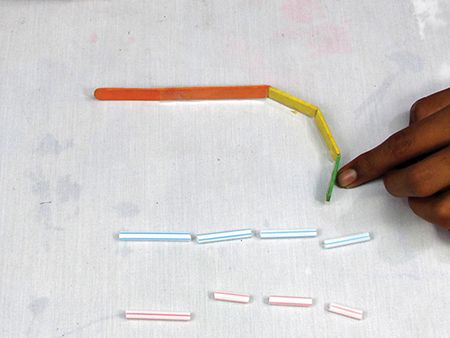
Fasten the straw segments onto the sticks now. You can just tape them, but an easier way is to use hot glue. Careful! We use this high-level tinkering technique: make a little pool of hot glue, and then quickly dip the segments in one by one and stick them to their respective sticks, front and back. The longer ones should be touching end to end, the shorter ones centered on their sticks.
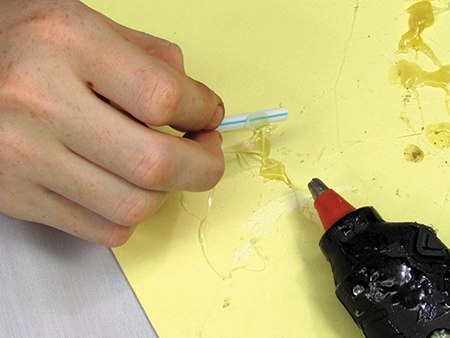

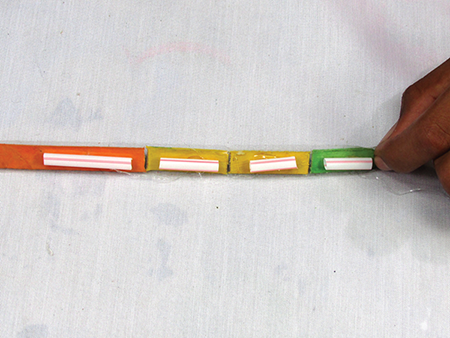
When they’re all sitting well in place, reinforce them with tape.
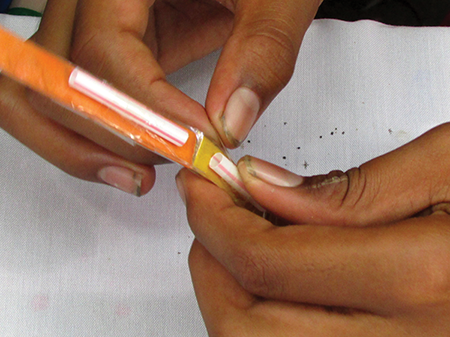
Now thread thin wire or string up through the straws on both sides. Tie off the end to the tip or to the tip straw. Leave the other end of the strings a bit long to hold on to and make little knots or stirrups on that end.
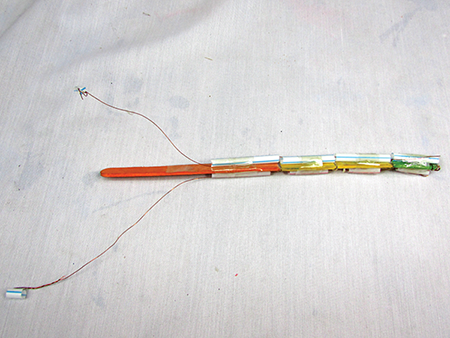
Now you’re ready for some real finger action. Hold it by the long stick and gently pull each of the wires.
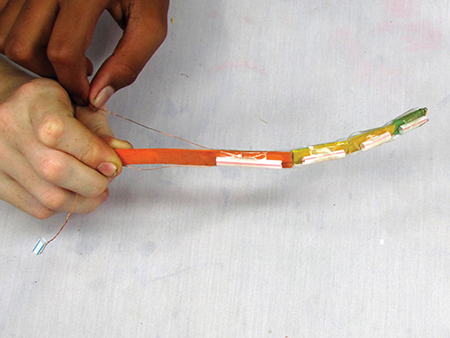
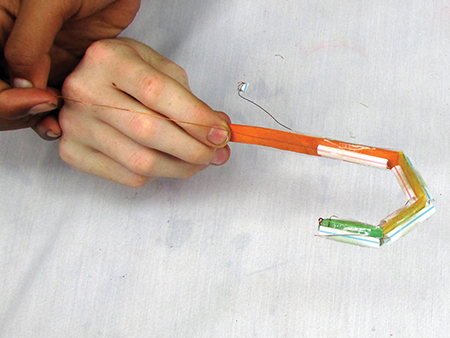
You see that the longer straw segments on the back line up and run into each other when you pull on their string, while the short ones on the front allow the finger to bend because they have gaps between them. You can tweak your finger by shaving off straws or adjusting their placement.
Now this one is like your finger, right? You let go and it just stays where it is!
What’s Going On?
In this model the sticks are the bones, the wire is the tendons, your pull is the muscle, the tape holding the sticks together are the ligaments, and the straws are the tendon sheaths.
A famous tendon sheath is the carpal tunnel. Heard that word before? Some people do the same action over and over like typing or playing the banjo, and the wrist tendons and their sheaths in the midst of that motion begin to get inflamed and sore. It’s called Carpal Tunnel Syndrome, and I suffered through it when I was a child. (I didn’t actually have it; my mom had it, but when she got her operation, she couldn’t get her wrists wet so my brother and I had to do all the dishes for nearly two months. It was grim.)
Muscles in your forearms pull on the string-like tendons that then pull on the bones. It’s a great system until it goes wrong. (My brother mowed into the back of my heel with a lawnmower when I was in third grade and sliced halfway through my Achilles tendon, the big one above the heel that puts a spring in my step. I’ve forgiven him.) Tendons get injured and heal fairly routinely. Both tennis elbow and shin splints are tendons acting up. If you take care of them and exercise, they’ll cure themselves. Ligaments don’t heal nearly as easily; if you tear a ligament, you’ve got serious problems.
Another thing this model shows is the truth about the way muscles impart force: they always pull, never push. Even when you’re pushing, it’s happening by means of muscles pulling on the levers of your arm and hand bones. As you pull your two wires, remember that you almost always find two: one to make the motion and one to retract.
See if you can think of other parts of the musculoskeletal system to make models of—we’ve done arms, legs, and vertebrae as well!
